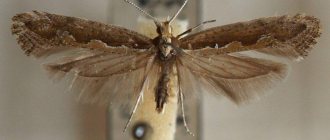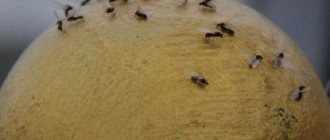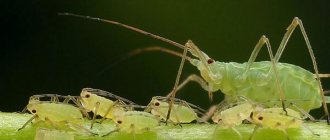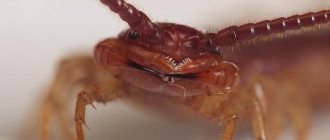A moth is a small gray butterfly that settles in a person’s home and causes a lot of trouble. Its voracious larvae eat items made of fur, wool, felt, felt, natural fabrics, and spoil book spines and food products. To avoid such troubles, you need to know what moths are afraid of and how to quickly get rid of them.
Every housewife should know what moths look like, since their larvae cause a lot of harm.
Features of using folk remedies for moths in an apartment
All known methods of getting rid of pests differ depending on what type of moth you have to fight: clothes moths or kitchen moths.
But they all have the same quality: they simply repel insects without destroying them . The only drawback of all these methods is their slow action.
Next, we’ll tell you in more detail about how to get rid of moths in an apartment using folk remedies?
We lure enemies of pests
Don't complain that your crops have a lot of pests.
These same pests have no less enemies: predators simply destroy them, parasites lay eggs on their body, and the hatched larvae then feed on the body of this insect. Many predators and parasites perform double duty, being at the same time pollinators of cultivated plants. These are the insects that are beneficial to you and need to be attracted to your plantings. But for this you need to know something about their biology and preferences. Crawling predators (spiders, ground beetles and others) love shaded, damp places and live among low, densely growing plants such as savory, rosemary, and mint. Ground beetles prefer nightshade plants and acorn grass. Flying predators and parasites include ladybugs, lacewings, parasitic flies and predatory wasps. parasites. The adult lacewing insect and its larvae kill caterpillars, beetle larvae, aphids and eggs of some pests. They lay their eggs in shady, cool places, such as thickets of ferns or evergreen shrubs. The ladybug chooses tansy and yarrow for laying eggs. Parasitic wasps (Chalkidae, Ichneumonidae, Trichogramma) are very effective in controlling the proliferation of caterpillars, aphids and other soft-bodied insects. Adult insects feed on nectar, and their young insects feed on caterpillars and larvae. Since these wasps are very small, they take nectar from small open flowers - such as anise, dill. Plants of the celery family provide a good shelter for parasitic wasps. Predatory wasps and flies (hoverflies, moths) are attracted to plants from the aster family - goldenrod, chamomile, daisies, as well as various types of mint - catnip, peppermint and spearmint. The tastes of insects do not coincide with ours: if we like large, beautiful flowers, then predatory insects are more attracted to small, inconspicuous flowers of savory, chamomile, and especially plants from the celery family. Hover flies, which kill aphids and soft-bodied insects, prefer to obtain nectar from flat, open flowers such as daisies and marigolds.
| Marigolds attract hover flies, which kill aphids and other pests |
Such plants can be placed along the edges of the garden or border areas with vegetables. You should select types of plants so that they bloom for a long time, replacing each other. Marigolds, alyssum, tansy, chamomile, and daisies are suitable for this. Savory, lavender, hyssop, basil, rosemary, and oregano bloom for a long time. They can be used as border plants. Most plants in the celery family bloom in mid to late summer, while biennial parsley and carrot plants produce early spring flowers. An interesting way to attract beneficial insects to a citrus orchard is described in the book “One Straw Revolution” by Masanobu Fukuoka. In his garden, he planted Morishima acacia - a tree that grows all year round and constantly forms new buds. Aphids feed and reproduce in large numbers on these buds. Ladybugs, in turn, feed on aphids, and they also multiply intensively. Having destroyed all the aphids on the acacia, ladybugs are forced to move to citrus trees, where they begin to eat their pests: mites, scale insects, and scale insects. We don't have Morishima acacia growing here, but obviously a similar technique could be used with some other plant that is loved by aphids. In English literature there are similar ideas: in order to protect cabbage from pests, clover was planted under it. When white clover was sowed under Brussels sprouts, the number of adult cabbage white caterpillars decreased significantly, although the number of eggs laid by the butterfly did not decrease. The reason is that the number of predator insects, ground beetles and spiders that ate the caterpillars increased by 2-3 times. Root fly damage to roots has been reduced. The cabbage harvest has increased. Overseeding red clover under cauliflower was less successful, although the number of cabbage aphids was reduced several times and the number of root flies was reduced by 1.5 times. But red clover grew faster and more actively than white clover, which had a depressing effect on cabbage due to simple competition.
| White clover increases Brussels sprouts yield |
Orange peels
Orange peels, as well as lemon and tangerine peels, are an old folk method of getting rid of moths. Their strong odor frightens adult butterflies .
Where the crusts are laid out: in cabinets or nightstands, they do not lay eggs. This is good for preventive purposes or to repel insects.
Rules of application:
- Place fresh citrus fruit peels near food products.
- Peels that dry out and lose their flavor must be replaced promptly.
Laundry soap
Another popular, but most importantly universal method , the main disadvantage of which is the unpleasant odor characteristic of soap.
Few people will wear expensive and beautiful clothes if they smell of laundry soap.
But laundry soap repels adult individuals and very noticeably limits the movement of caterpillars . This product is affordable to any buyer. It is especially convenient to use it to get rid of insects that have settled in pantries and closets.
For quality use, place pieces of fresh laundry soap inside kitchen furniture or place them in the pockets of clothing that needs to be protected.
Lavender for moths
Lavender is considered the most popular folk remedy. This plant has a strong and very pleasant smell. It doesn't run out of steam for a long time. Lavender effectively repels both caterpillars and adult butterflies .
At the same time, dried flowers and essential oil made from the plant , which is a component of many industrial products used to get rid of insect pests, are equally effective.
Place the leaves of the plant in porous bags around the apartment, place them in the wardrobe between stacked things . If we are talking about essential oil, then it is placed on the shelves of cabinets directly in open vessels.
Clothes can be protected by spraying them with lavender infusion . You just have to do this often.
Important! Do not spray lavender or any other essential liquid onto your clothing. The quality of this product varies. If it contains at least a little palm or sunflower oil, stains will remain on things that are difficult or even impossible to remove.
How plants repel insects
Plants contain organic compounds - essential oils. They are found in various parts: leaves, flowers, roots, fruits and seeds. For effective pest control, use those parts that contain the most essential substances.
Many people are interested in how a moth will sense the smell of a referent if its source is hidden in a closed cabinet. According to microbiological research, the pest butterfly is able to sense a minimal amount of odor at a distance of 1 mile. She can easily smell an unpleasant substance behind the cabinet doors.
You should not be afraid that moths will not be able to scare off repellents, the smell of which a person cannot smell. Pests will not fly into the room where horse chestnuts are laid out, although their smell is not noticeable to people.
The essential scent does not kill moth eggs and larvae, but only repels adult insects. Odoriferous substances are used for prevention, not to kill pests.
Therefore, it is necessary to take precautions when storing food and clothing:
Only clean items that are pre-treated with chemical insecticides or essential oils are placed in wardrobes. The smell of unwashed clothes attracts pests; moth larvae readily eat contaminated parts. Bulk products in which moths infest are stored in tightly sealed containers. Do not allow food to get wet, as pest larvae prefer a moist environment. What herbs repel moths
Repellent plants that effectively drive away moths are grown on the windowsills of kitchens and apartments. A butterfly that smells them will fly around these rooms.
Wormwood
It lives in the wild, but many species are grown on balconies, terraces and loggias. Indoor varieties of wormwood have been bred, which are distinguished by their spectacular silver color and beautiful leaf shape. They have the beneficial properties of wild wormwood, but grow year-round.
This plant can be called a champion in repelling household pests. Its specific aroma drives away moths, cockroaches, fleas and other parasites. To control pests, use wormwood branches, dried in a dark and ventilated place. They are placed on the shelves of cabinets and pantries.
To prevent the plants from falling off, crushed dry wormwood is placed in a sachet. They are hung in closets, placed in the pockets of fur jackets, coats and fur coats, and placed in bags with woolen products.
Oregano
This plant has another name - oregano. It has long been used to repel moths and other domestic insects. Oregano is popularly called bedbug grass or flea grass, which indicates its insecticidal properties, useful in the fight against parasites.
There are indoor varieties of oregano that have an attractive appearance, pleasant taste and aroma. They are used as spices in dishes, added to pickles and preparations.
Chamomile
Bright, elegant inflorescences of Dalmatian chamomile (pyrethrum) are found in flower beds, borders and ridges. Low-growing varieties are grown on balconies, loggias and in rooms. This plant has long been used to control insects. Crushed pyrethrum flowers are used for the industrial production of insecticidal powders.
The smell of chamomile is unbearable for butterflies and moth larvae. To preserve woolen items, insecticidal powders are added to the rinse water. Sachets with fragrant pyrethrum are placed in wardrobes.
Rosemary
Fragrant bushes are grown not only in the country, but also at home. The plant is used as a spice, adding a special taste to dishes and preparations. The smell of rosemary is not tolerated by moths. Fresh or dried branches of the plant are placed on the shelves of wardrobes and kitchen cabinets, and placed on furniture. The essential aroma is exhausted, so the branches are often renewed.
Lavender
This plant with delicate purple flowers and a wonderful aroma is grown not only in flower beds, but also at home, in flower pots. Dried lavender inflorescences retain a specific smell.
To repel moths, use fresh and dry parts of the plant, which are placed in cabinets and in the kitchen. Dried flowers are sprinkled onto linens for scent and placed in sachets for hanging on hangers. A decoction is prepared from lavender, which is used to wash kitchen cabinets, and dry herbs are scattered in the corners.
Mint
Like lavender, this plant has a strong scent .
It is used in a similar way: the dried leaves are laid out in small bags and placed where there should be a large concentration of pests.
From time to time it is recommended to check whether the pouch is exhausted. If this happens, replace it with another one with fresher dried leaves. To increase efficiency, you can place them in the wardrobe in the pockets of sweaters, coats, fur coats and jackets .
Geranium
The fight against small gray butterflies that have settled in the house is not always active and involves the use of means specially prepared for this. There are also passive ways. Often it is enough to place an indoor flower on the windowsill, like an ordinary geranium .
Many insects cannot tolerate the smell of this plant. If the apartment is large, get several bushes. Place one pot in each room. Geranium is equally effective against both kitchen and clothes moths.
Always keep live flower bushes in your apartment. Periodically open kitchen cabinets, wardrobes and bedside tables, ventilating them once every few days.
Why is it dangerous?
Traces of moth activity.
Moths harm the household of any family. The fact is that during reproduction, a large colony eats fabric and fur items, as a result of which various holes are formed.
It is very disappointing when harmful insects spoil a beautiful fur coat or hat, which are very expensive.
There is another problem: multiplying quickly, large offspring will crowd out a person. These insects will crawl into a person’s mouth and nose, sit on their owners’ faces, and devour things. In general, a lot of inconveniences.
In the evening they will fly towards the light, as their instincts are triggered, and at night they will land on the face, which will cause great discomfort to a person.
Which moth is more likely to appear in the house?
Food Clothing
horse chestnut
It turns out that chestnut protects well from insect pests. Its seeds should be collected in late autumn.
After drying them in the oven (raw chestnuts quickly become moldy), place them on shelves in the cupboards. You won't need bags here.
Chestnut has several advantages:
- The fruits are easy to collect and just as easy to arrange;
- They act effectively and do not have a strong aroma ;
- The fruits are quite large in size, so they are not capable of littering the apartment.
Chrysanthemums
The ingredient in chrysanthemums that makes them such an effective insect repellent is pyrethrum. Chrysanthemums repel ants, Japanese beetles, ticks, lice, fleas, bedbugs, spider mites, beetles, etc.
Pyrethrums in chrysanthemums can kill flying and jumping insects, are used in the most common American home and garden insecticide, and are often used in room sprays, homemade shampoos and aerosol bombs.
However, pyrethrum may be a human carcinogen and caution should be exercised. Make sure you are not at risk
Vinegar and garlic
Vinegar and garlic do not have a very pleasant smell. Although it is precisely because of it that they are considered a good means of fighting insects. It is better to store garlic in the kitchen, inside cabinets or in pantries next to other food products, and it is recommended to add vinegar to the water when cleaning the floor in the apartment.
The butterfly does not tolerate spicy plants, including thyme, rosemary and cloves. They can be placed in bags, combined with each other, or used each separately. Such sets are distributed throughout the apartment and repel pests from the premises for a long period.
Rosemary
Rosemary repels mosquitoes and other insects that are harmful to plants. Rosemary is available today in various forms. The plants can be grown in pots on the patio and shaped into ornamental bushes in the garden (some varieties can grow quite large). Rosemary is also wonderful in cooking. The plant and its cuttings themselves are effective repellents.
You can make a simple repellent spray: boil 500 grams of dried rosemary in a liter of water for 20 to 30 minutes. Then cool and pour into a container with a dispenser. The solution must be stored in the refrigerator!
Other herbs:
- Bay leaf: repels flies. Dried bay leaves, which are sold in stores for adding to soups and stir-fries, are not suitable. Therefore, grow bay leaves at home.
- Onion: repels flies, Japanese beetles (aka Japanese beetles) and aphids.
- Dill: against aphids, edgeworms, spider mites, cutworms, cabbage and hawk moths.
- Fennel: Helps control aphids, slugs and snails.
- Melissa officinalis: repels mosquitoes.
- Oregano: repels many pests and adds moisture to the soil.
- Parsley: repels various bugs.
- Thyme: repels whiteflies, armyworms, etc.
Fragrant tobacco
Tobacco is another effective folk method against gray butterflies. Fragrant tobacco is usually used as a houseplant, but as for smoking tobacco, it is better to use it in the form of small dry leaves, as in the cigarettes we are used to.
Place regular tobacco in bags and place inside pieces of furniture. Don't forget to ventilate your wardrobe periodically.
Attention! Do not use tobacco to protect clothing from moths. Things soaked in it will lose their attractiveness.
Popular questions
To understand at what temperature the moth dies, it is worth noting that apartment conditions are the most ideal for the parasite. Sharp jumps, both upward and downward, are dangerous for the insect. At +53°C, 10 minutes in the sun is enough; at +45°C, half an hour is needed.
If things need to be boiled, this will get rid of moths in a few minutes. At -5C it will take a day, and at -20°C half an hour will be enough. Much will depend on the density of the fabric.
What repels moths in the house cannot kill the larvae. And they are the ones to be afraid of. Adults do not spoil things because their oral and food apparatus are reduced.
It is important to know how to drive away an insect. They say that even if you put dried snake venom for moths, it will be safe
This once again confirms the omnivorous nature of the parasite.
Since moth larvae can even damage a plastic bag to get food, it is important to know what moths do not like. Strong aromas and temperature changes are unacceptable to the parasite.
That is why, with constant ventilation, daily cleaning and frequent drying of things in the sun, the winged insect rarely looks into the house.
The larvae are more resistant to aromas, but when things are shaken, they quickly leave their new home, since they do not have any attachment. The best method of dealing with masonry is thermal and mechanical surface treatment.
Scented herbs
Insects are repelled by bunches of wild or cultivated fragrant herbs. Among them, the most effective means are the following:
- Sagebrush;
- Tansy;
- Chamomile;
- Valerian;
- Marigold;
- Carnation.
Other folk methods and means to repel annoying pests:
- Camphor . Soak swabs in it and place them in places where butterflies accumulate.
- A combination of lemon and cloves . The buds of a spicy plant are stuck into half a lemon and suspended on a strong thread above the shelves with things.
- Pieces of cedar twigs and wood are also not carried by insects. Place them in wardrobes where fur coats hang. You can also use cedar needle oil for this purpose.
- black pepper (peas) using the same method .
- Residents claim that sometimes gray butterflies are repelled by the smell of fresh newspapers . But experts consider this method rather dubious.
Advice! To prevent insects from infesting the kitchen, the best solution would be to store cereals in closed containers or tightly tied bags. Before storage, clean outer clothing and put plastic covers on it.
Do not forget to regularly ventilate the apartment and constantly clean it using disinfectants. Moths are afraid of low and high temperatures. So washing in hot water, frying clothes in the open sun or airing in frosty air makes it possible to get rid of females, eggs of pests or their larvae.
By the way, the larvae and eggs are attached to clothes very weakly, so they fall to the floor at the slightest shaking. For this reason, items that are constantly worn are rarely damaged. Those who hang in wardrobes for a long time and wait in the wings suffer the most.
Newspapers
Moths cannot stand the smell of printing ink. Our grandmothers covered the shelves of cupboards and wardrobes with newspapers. To protect your favorite fur coat from damage, you can remember the old folk method and put several crumpled newspapers in a case with outerwear.
To achieve the greatest effect, the press must be fresh. When storing winter boots in your closet, stuff your boots and boots tightly with crumpled up newspaper. In this way, two problems are solved: the shoes retain their shape, and moths will never appear in them.
Essential oils
Essential liquids are an excellent and very effective folk remedy for repelling pests.
fir, eucalyptus, rosemary oil, as well as patchouli, lemongrass and citronella oil are actively used .
Mode of application:
- Rinse the floor with water, after adding a few drops of essential liquid;
- Wipe the shelves and surfaces where moths may accumulate with oil;
- Lay out the swabs soaked in liquid;
- Spray cabinets and rooms;
- Place open bottles of anti-pest oils in wardrobes, kitchen cabinets and bedside tables.
Naphthalene
Perhaps the most famous and most effective folk remedy for moths is naphthalene.
IMPORTANT! today it is not recommended for residential buildings .
But mothballs are still popular and help get rid of butterflies and insect larvae that cannot stand its pungent smell. Bags of mothballs are usually placed between stacks of clothes on the shelves of wardrobes.
Naphthalene is not able to fight food moths (more about fighting kitchen moths), only clothes moths, since food actively absorbs odors. Therefore, it would be unwise to expose food to spoilage. But there are many modern substitutes for naphthalene against pests that are no less effective.
Modern chemical compounds, which are freely sold in specialized stores, are always ready to help folk remedies for moths in the house.
But you shouldn’t neglect your grandmother’s old methods either, which, as practice shows, do not lose their effectiveness over the years and can be used when really necessary.
So, we told you how to fight moths using folk remedies, described flowers and plants that repel the pest, and also gave advice on how to remove moths from the kitchen using folk remedies?
NOTE! Find out where moths come from in an apartment? Did you know that wax moth exists, and the tincture of its larvae has many medicinal properties.
Review of chemicals
As a rule, the use of chemical means of control is started when folk and available substances do not cope with their task. Chemicals have a great effect, but their use requires special protective equipment and a number of recommendations, as well as preparatory operations. The whole point is that at the time of processing the premises there should be no residents in it. Sometimes such conditions are simply impossible to meet. This is especially true when sick people who are unable to move independently live in the house. In addition, you need to find a roof over your head to wait until the chemistry wears off.
Special anti-moth sections
Such means of control are placed in closets, chests of drawers, etc., where these insects like to climb. There are types of plates that can be used even in the kitchen. These plates are valid for 6 months. They repel insects due to the unpleasant odor that these plates emit. As a rule, after some time the moth will completely disappear from the apartment.
The plates “Moskitol”, “Raid”, “Armol” and “Raptor” are produced. Manufacturers have thought about how to conveniently attach the plates anywhere. In this regard, this type of product is very popular.
Using moth traps
The traps are distinguished by the fact that they are absolutely safe for others, but have a detrimental effect on males, attracting them with a special aroma. Therefore, over time, the reproduction of insects decreases and, as a result, the moth disappears. This type of trap is safe for humans, since there are no harmful vapors or any ultrasound that affects the hearing organs. Such products include Mosquitall and Raptor traps.
Aerosols
Some chemicals are available in aerosol form. Like all other chemical components, aerosols have a detrimental effect on larvae and adults, but can also cause allergic reactions and have an unpleasant odor. They are also not always suitable for use in homes.
Rules of application:
- Do not spray the product anywhere. You should focus on areas where larvae and adults are concentrated.
- Aerosols are sprayed only when wearing personal protective equipment.
- Before spraying begins, all family members with pets must leave the apartment.
- You can return to your home only after the time specified in the instructions.
- Before returning, it is advisable to do a wet cleaning by wiping all surfaces with a soap and soda solution.
Recommendations for the use of aerosols:
- Aerosol "Raptor".
- Aerosol "Dichlorvos".
- Aerosol "Raid".
- Aerosol “Clean House”.
- Aerosol "Difox".
- Aerosol "Extra Mit".
Spray
Sprays are produced in plastic containers with spray nozzles. Some of the drugs have a high degree of toxicity. Such control agents effectively destroy insects and are also suitable as a prophylactic agent.
The product is sprayed onto knitted and fur items, including the surface of furniture. Often the moth dies after the first treatment.
Compositions available for use:
- ARGUS.
- Mosquitall.
- Tornado.











